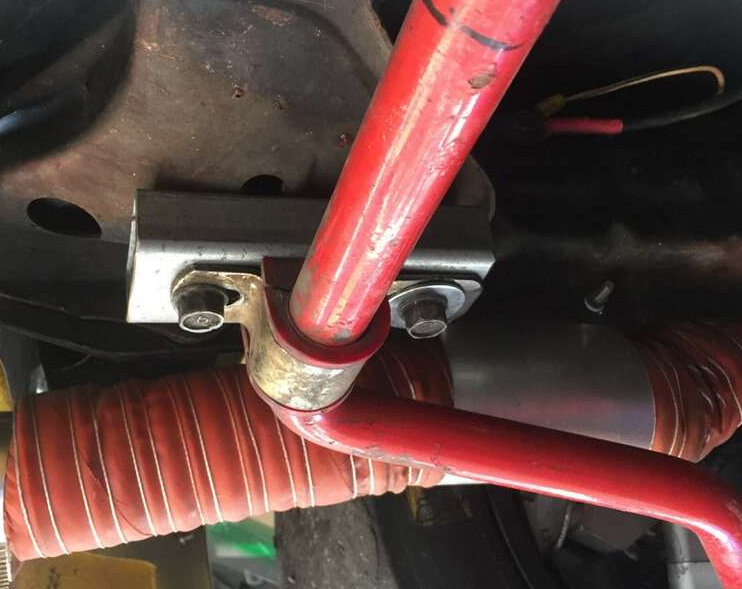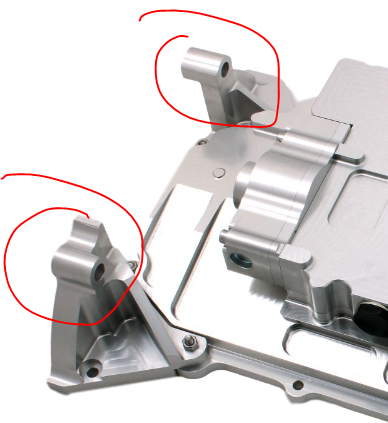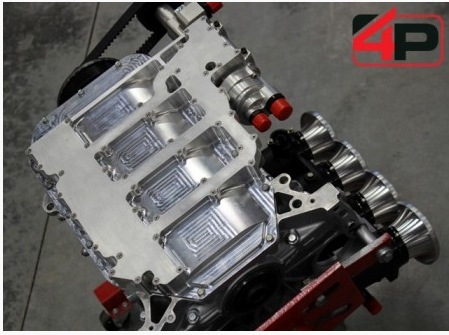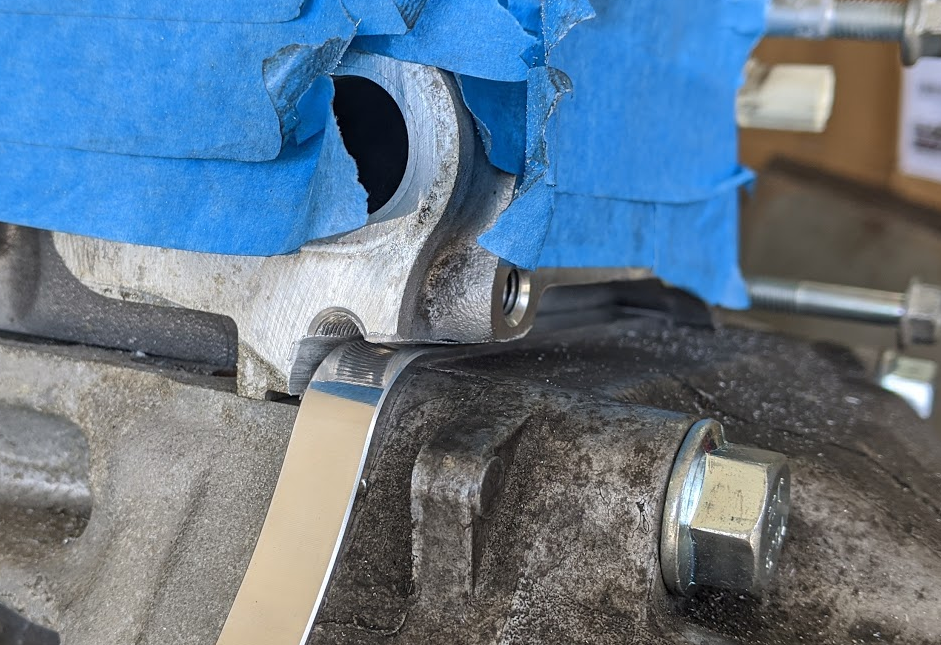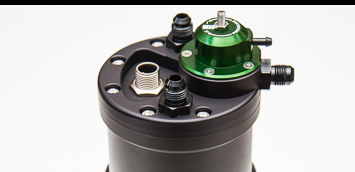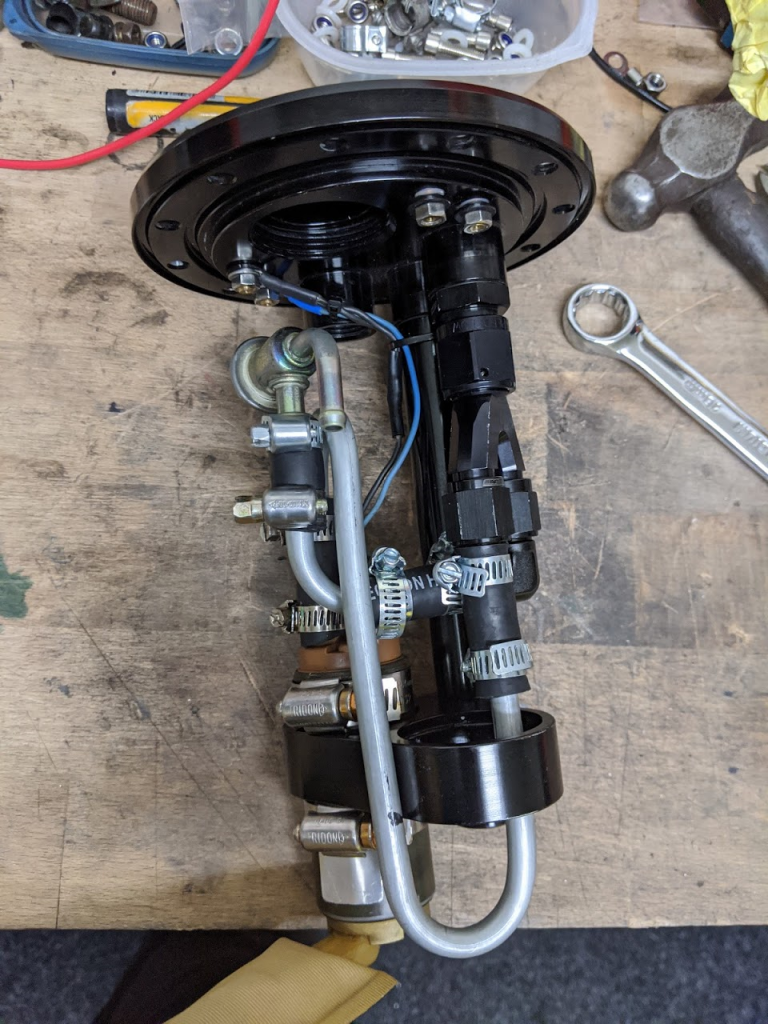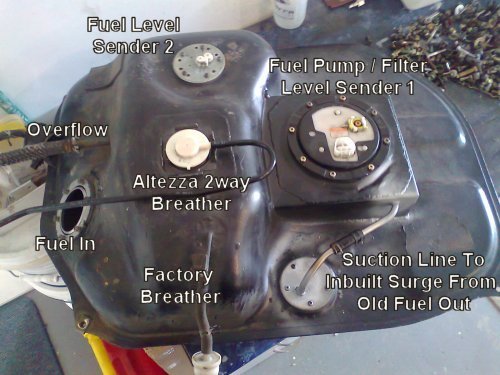

Hyperblade
Members-
Posts
336 -
Joined
-
Last visited
Everything posted by Hyperblade
-

Hyperblade's KP61 Racecar "KP61R" Discussion
Hyperblade replied to Hyperblade's topic in Project Discussion
No plans at this stage, will see how we go when we get to it, the steering arms are T3 so have a bigger center, so i'm sure we will work something out. Ouch, that's an expensive mistake! Yeah it's not just the pans, but the pump, container and fittings. And because it's all over $1000 you get stung with GST + Duty importing it, so your looking at upwards of $5000nz to do. -

Hyperblade's KP61 Racecar "KP61R" Discussion
Hyperblade replied to Hyperblade's topic in Project Discussion
I was running the front sway bar (which does the castor on the lower arms) 25mm lower, this is the easiest way to reduce the diving as it reduces the leverage, it's relatively easy to do as you can see below, so doesn't have to be a massive amount, any little bit will help. For me as I'm moving to a front rack it makes sense to move to the escort style anti dive, but otherwise the above worked well. Yep, dry sump was considered but just too pricey, a single stage wet sump is also an option, but the pulley is really expensive for it. However the only dry sump i saw with the correct mounting was the AT Power one, all the others appeared to having the same problems as the other pans. vs Daily Engineering one. -

Hyperblade's KP61R - Toyota Starlet with Honda K20a
Hyperblade replied to Hyperblade's topic in Projects and Build Ups
Now that's what I'm doing, however if you wanted to run it over the cross member you might consider the following kit from K Miata. https://kmiata.com/collections/kmiata-swap-parts/products/k-series-miata-oiling-solution Or a Ktuned Steel Oil Pan and chop it up. https://www.speedscience.co.nz/products/k-tuned-steel-oil-pan-k-series Or a Moroso Pan https://www.speedscience.co.nz/products/moroso-baffle-sump-w-trap-doors-k-series-incl-k-swap However be very careful as the standard cast aluminium oil pan has the bottom 2 bolts for the gearbox. And also this massive brace back to the bottom of the very solid pan. Replacing the pan with one of the above means you can't bolt the gearbox at one of it's highest stress points, i.e it want's to separate right at that point. Basically your going to fuck your main bearings with the forces on it. So that's out for me, if I need to I will cut up the existing pan. In terms of baffling, I have some pics of a Spoon K20 sump baffle, and @Roman did a great write up on improving the BEAMS sump to match the TRD version which I saved, so a combination of both should work out well. Main thing is stopping the oil freely going up the oil chain under braking. Here's a standard sump, which is just a dumb design: -

Hyperblade's KP61R - Toyota Starlet with Honda K20a
Hyperblade replied to Hyperblade's topic in Projects and Build Ups
Next up was the oiling. The K20a from the Accord Euro R runs balance shafts off the oil pump in the sump. These are to reduce vibration at lower revs, the Integra and Civic versions don't have these so it's safe to remove them (or just buy an Integra/Civic engine to begin with...). The downside is they take up a huge amount of space in the sump, they sap power(supposedly about 9whp) and they weigh 5.3kg alone! So it's a win to remove them all round. Luckily you can raid the Honda parts bin, so the standard thing to do is to buy an Civic FD2 kit to replace them, it comes with a new oil pump, oil chain, oil chain guide and windage plate. So many stores sell these kits as the K24 engines also have them, so it's a pretty easy change. One thing is that the K20a oil pumps are known to not be great over 9000rpm, so a lot of stores are now porting the oil pumps which frees up a little bit of power and makes them safe to 10,000 rpm. I ended up going with one of these kits as it ended up cheaper than a stock kit, one thing to note is the K24 engines and the Euro R version of the K20a need the housing of the oil pump modified for clearancing, it's nothing major and the kit i brought already had it done. I brought the kit from kmodperformance with it being the K24a2 version which bolted straight up. https://www.kmodperformance.com/collections/bottom-end-engine-parts/products/kmod-oil-pump-kit?variant=9987006988324 Now that frees up a lot of space! Now a few might be wondering how i'm going to fit it in the car even with that sump. The plan is to put the steering rack on the front of the engine cross member (escort like) narrow the cross member and position the engine entirely behind the cross member or as far back as we can get it. There are a few challenges with this as I have a roll cage bar going through the dash, so would like to not have to alter that and it may put the gear lever quite a wee way back, but will deal with that later. It has some big advantages however, obviously the position is great from a weight balance point of view, but it also allows me to run escort style anti dive bars (tied from bottom arms BACK to chassis), which make a huge difference in braking. Yes there is going to be a lot of chopping. -

Hyperblade's KP61R - Toyota Starlet with Honda K20a
Hyperblade replied to Hyperblade's topic in Projects and Build Ups
So having picked the engine/gearbox it was now a case of bolting them together. This is relatively easy, all you need is an adapter plate, and an off the shelf flywheel to suit. So what you are looking for is K2F as a search term as it's a pretty common conversion. I ended up going with a JSPFab adapter plate as they were half the price of everything else once landed, had all the hardware and had good instructions. https://jspfab.com/collections/f-and-k-series-engines/products/jsp-billet-k-series-to-f-series-transmission-adapter They were great to deal with. To fit I needed to clearance the adapter plate to the head (for k24's you don't need to do this as the block is taller), I chose to clearance the head vs the adapter as the top of the adapter is free floating on the engine so I wanted as much strength in the plate so the gearbox didn't move around. A little bit of chopping some unused bits of the head and it fits great. This keeps the engines 15 degree right hand lean. Next was the flywheel, the most common one found in many stores was the ClutchMasters FW-K2F-AL http://www.clutchmasters.com/aluminum-flywheel-fw-k2f-al/ It weighs about 4.5kg, and has a replaceable friction surface which is awesome (no need to resurface), it also came with all the clutch plate bolts. This allows any standard S2000 clutch to bolt up, which gives a lot of options, the downside is S2000 clutches are more expensive than say a K Series. -

Hyperblade's KP61 Racecar "KP61R" Discussion
Hyperblade replied to Hyperblade's topic in Project Discussion
Yep, had seen those, I will be doing custom sump baffles. -

Hyperblade's KP61R - Toyota Starlet with Honda K20a
Hyperblade replied to Hyperblade's topic in Projects and Build Ups
So next question is what Gearbox to use? J160 + get adapter made to suit. MX5 6 Speed BMW S2000 AP1 S2000 AP2 There are pros and cons to each I ended up going for the S2000 AP1 gearbox. Here's why. J160 has no aftermarket internals support, basically you stuff one, you throw it out and replace it + cost to make adapter + flywheel. MX5 basically same as J160. BMW, I stay away from Euro so no thanks. That left the obvious choice of the S2000 AP1 or AP2 boxes. Pros: Lots of adapters from different companies to bolt them up to. Sold in the USA, means Honda OEM parts are easily available, I can buy bearings, gears, syncros from any number of stores. They were built for 9000 rpm, K20a will go to 8800rpm so a good match. Known as one of the best shifting boxes out there. Main difference between the AP1 and AP2 is the ratios and the AP2 run carbon sycros (AP1 got upgraded to these later on so can buy off the shelf from Honda for them now). Note the S2000 box is not another version of the J160, it runs a secondary shaft in the gearbox and runs another set of gears to alter the output ratio. Here's some comparisons I did of the ratios (I run 4.55 diff at present and have 4.3 spare) I'm currently hitting rev limiter before end of the straight, so something slightly higher will be good but not by much. I went with the AP1 as you can see it gives me a bit more room at the top end, and i can go to 4.3 which is a common AE86 ratio if required. All of this means a critical speed for the driveshaft of around 9354rpm, which is fairly high. Getting a S2000 box is a lot harder then getting the motor, but i managed to find one and have had it stripped down, and going to replace bearings etc.- 72 replies
-
- 13
-

-

Hyperblade's KP61 Racecar "KP61R" Discussion
Hyperblade replied to Hyperblade's topic in Project Discussion
Yep, oiling is a big issue on the K20a made even worse when you turn them around as under braking all the oil goes up the cam chain area, I have a plan for that though. -

Hyperblade's KP61R - Toyota Starlet with Honda K20a
Hyperblade replied to Hyperblade's topic in Projects and Build Ups
So as has been guessed it's a Honda K20a Euro R motor (Basically same as Type R, but more on that later.) These only come in fwd layout, so obviously that's going to make things challenging. They came in the following cars So Why Change? The 3SGE Beams Blacktop is a good engine, it's been very reliable and I've had no issues, however when you look around there is very few of them around the world which means the aftermarket support is limited and there are very few experts with them. CelicaRA and Harris Engineering (Previously Lyn Rodgers) being the main ones who have any experience modifying them significantly, the older 3SGE engines have a lot more support. Being RWD already they are cheaper than putting a K20a in and if you keep them internally stock they are a pretty good package for a lot of cars, but they are a cast block so weigh a lot more than an aluminum one. I wanted a little bit more power. I wanted to remove weight from the car. I wanted better aftermarket support. I wanted to keep the engine internally standard for now for reliability. I wanted easy availability of them. Why K20a vs F20c? The F20c is hard to get and not cheap. Honda took what they learnt from the F20c and made the K20a so it's a better engine, and also more supported. Why K20a vs K24 Need to keep in the under 2L class. Why is there such a large aftermarket support for the K20a/K24? The USA, Honda produce so many cars for them and they made ones which feature a detuned variation of the K20a which means all the companies got stuck in producing performance parts, and as the engines are so similar it's basically a massive parts bin of bolt on parts. Why Euro R version? Ideally (will explain later) you would go for the FD2 version as that's the best by a little bit, however as these are newer they are much harder to find. DC5 ones would be next on the list but they are also very popular so hard to find. The Euro R version however is relatively easy to get. The Euro R is slightly different, it runs a different ratio gearbox with different mounts and wasn't produced for the USA, so makes support for it just a little bit trickier with some items. It has balance shafts in the sump attached to the oil pump, and the ports on the head are supposedly slightly smaller (might be a good thing) (but where manifold bolts up is the same), the head water outlets are slightly different design. However pistons, cams, valves, water pump, cam cover, pretty much everything else is the same. You can think of the Euro R K20a as being a K20a Block but with a K24 head, but running all K20a Type R internals. Being it's similar to a K24 head that means you can take advantage of all the K24 parts available, while still using K20a Type R parts for everything else. It's not a major but does have an impact on some things. e.g if you need to do anything with the sump (which you should baffle) you need to get rid of those balance shafts, luckily this is just a case of bolting a oil pump kit from an FD2 on (which many stores sell). The ECU is also not tune able unlike the other versions, for me that was a non issue as i will be using an aftermarket one. It also runs the best intake manifold out of all the K20's (RBC) which everyone wants to bolt on to there K20's for more power. The Conversion Package So after looking around I decided to go for a Euro R complete engine conversion package from Strong Hondas Auckland, they were great to deal with and I ended up getting one with 112'000k's, was completely hassle free, and would have had a warranty if not for it going in a racecar. So for $3,390.00 incl delivered to CHCH I got the following. Engine Gearbox (with LSD) O2 Sensors Gauge Cluster Headers Driveshafts + Intermediate Shaft Shift Lever + Cables Engine Loom + Body Loom ECU Clutch Pedal + Master Cylinder Brake Pedal Flywheel + Clutch (worn) Intake manifold + throttle body All sensors except Air Intake Sensor. Misc Cooling Hoses Obviously that's a lot of money, but if you were doing a conversion into another Honda that is a bloody bargin for everything you get. So after I sold off things I didn't need, the engine is currently owing me $981.73... And I'm still to sell: Gauge Cluster Headers Engine Loom + Body Loom ECU Throttle body That's a pretty good starting price, but I have to buy conversion parts so they will add up quickly... -

Hyperblade's KP61 Racecar "KP61R" Discussion
Hyperblade replied to Hyperblade's topic in Project Discussion
Your going to love what i'm going to post, I will go into detail on reasonings, differences, sizes etc I happen to have my spare BEAMS motor sitting the garage so easy for me to compare at the moment. S2000 AP1 box. -

Hyperblade's KP61 Racecar "KP61R" Discussion
Hyperblade replied to Hyperblade's topic in Project Discussion
It's not a cheap swap, but there is some stuff that would make it easier, I will be very detailed. I can't weld so the main fitment will be done by Bert @ palmside exhaust done by JPW Performance and I think I can do the rest with off the shelf parts. Feel free to ask away here happy to answer questions, I am working with Speed Science on giving them updates for their facebook, so I can't get ahead of those, but I can be a lot more detailed here. 2L K20a Type R motor The rear sway bar made a huge difference, the car was so much flatter, even with the valving wrong in the shock it was an improvement. I had Bert drive the car and he picked up the valving being wrong straight away, but said overall the car handled really well, so fingers crossed the car is transformed when i get the shocks back. Here's with no sway bar. Here's with the sway bar. -

Hyperblade's KP61R - Toyota Starlet with Honda K20a
Hyperblade replied to Hyperblade's topic in Projects and Build Ups
Teaser: Now interestingly enough a certain someone @Roman had some interesting comments on this engine in 2007 on another forum. and than went onto have a long discussion about the merits vs the BEAMS -

Hyperblade's KP61R - Toyota Starlet with Honda K20a
Hyperblade replied to Hyperblade's topic in Projects and Build Ups
Been a while since I've updated this. Decided to do a cold airbox around the existing filter. Made no difference to intake temperatures, still up around 40 degrees, i suspect it's heat soak through to the filter plate where the sensor is mounted. I've been struggling with keeping the rear brake temperatures down, and it's been meaning the front have been doing more work and they started getting a bit hot and micro cracking. Also into the hairpin which is where the brakes are the hottest the car just hasn't felt like it's slowing as fast as it should considering the weight, which I picked was the rears going to hot and losing the friction. Before they become full cracks in the rotors I had to sort the rear out to relieve the strain on the front, some new AP Racing rear brakes, same calipers as the front just 20mm wide instead of 25mm, with full vented 2 piece rotors were fitted. It's a very tight fit behind the rear wheels so they are slightly smaller in diameter than the front. Thankfully that's finally got all the temperatures sorted, and both front and rear are now way down, so that's finally solved that issue, don't let anyone tell you the rear brakes do nothing on the track... I've been struggling with the new suspension. Changing so much at once made things hard to diagnosis some of the issues. I have now added a rear sway bar which has certainly helped in keeping the nose down now and helping with the turn in. However the car has been shuddering under braking and had no grip, tried softening everything still didn't help. Turns out the valving and pressure in the shocks is way to hard i.e SuperTourer figures (for a car that's significantly lighter), not sure what's gone on there, but getting revalved now, waiting on the lock down to end to get them back. But I've decided it's time to move on to Evolution 4 of this build. Evo 1: Street Car with 4AGE Evo 2: Race Car with 4AGE Evo 3: Street Car with 3SGE Evo 3.5 Race Car with 3SGE Evo 4: Race Car with ??? -
Yep, was expecting it to be an issue, can't run less then 10L otherwise get starvation tank takes 30L and car used 10L for an 8 lap race. I just keep it fully topped up, at the moment.
-
I was in a rush to get it all done for race day, so if i had run a FPR I would have had to find out the pressure it was running at before then match it, plus would also had to run all the return lines, this way i didn't have to get a retune, or stuff around with the rail. I also plan to put a surge tank in at some point, and i'm looking at a Radium one with the inbuilt FPR so would be a waste of money to buy another one in the meantime. http://www.radiumauto.com/FST-R-Fuel-Surge-Tank-with-Integrated-FPR-P348.aspx The other thing is simplicity, I hate how race cars have all these hoses going everywhere for fuel, it's just more points of failure, all that shit should be built into the tanks/surge tank. Normally you see in race cars (for returnless) Tank > Filter -> pump > Surge Tank > FPR > Filter > Rail FPR > Surge Tank Surge Tank > Tank Currently I have Tank > Filter > Rail Future Radium Setup will be Tank -> Surge Tank (FPR) -> Filter -> Rail Surge tank > Tank. That's pretty simple, and simple means more reliable and safer also. /end rant about how people designing motorsport products aren't understanding the problem the customer is trying to solve...
-
I was down to my last ones and getting desperate! The fact it works at all is a small miracle. Had to do the hard line to get everything in position. Could have brought more AN fittings but this is only v1 will tidy it up at some point (I'm sure everyone says that)
-
Just a further update. I've been putting all of this into a new fuel cell so was a bit unsure of what pressure the fuel needed to be at. Many posts on the internet were saying 62psi for the BEAMS engine. So to be safe I reused just the regulator and adapted it into the fuel cell. yeah was a bitch of a job as the whole lot had to fit in through the main hole... I also had a pressure gauge on the output which meant I could see the fuel pressure was at 51psi. Which i was a little bit worried about, but the car ran flawlessly at this pressure all day racing. I reached out to NST and they came back to me with the correct Toyota part number for the whole unit which is 2302074010. Now looking that up on Amayama shows that that unit is used across 3SGE, 1GFE, 1MZFE, 2MZFE, 5SFE, 3SFE engines. https://www.amayama.com/en/part/toyota/2302074010 Doing a cross match on the Lexus RX300 which has the 1MZFE engine found me this aftermarket regulator https://www.autozone.com/fuel-delivery/fuel-pressure-regulator/gp-sorensen-fuel-pressure-regulator-800-468/203289_594834_0 Which shows the operation pressure at 50psi. This ties up with what i had also read where the IS200 was the same part number as the RS200 one and it was standard 50psi. This of course all makes a lot of sense, as having one part means easier for Toyota to source and brings costs down, and they just change injectors and tune to suit. Hopefully this info helps someone in the future
-
Perfect timing. Thank you! For others: It is used to transfer fuel from one side of the saddle tank to another. It does that by using excess pressure from the pressure regulator.
-
Yep
-
The grey fitting I think went to the suction line. Is it some way of using excess pressure to transfer fuel from something to main tank?
-
Out of Toyota Altezza RS200 I've worked out the metal piece of this is the regulator which runs around 58psi. Buy what is the plastic grey bit for? Seems to act like a regulator too but at like 30psi. The partnumber appears to be for this entire unit. Anyone got any ideas how it works?
-

Hyperblade's KP61 Racecar "KP61R" Discussion
Hyperblade replied to Hyperblade's topic in Project Discussion
I was looking at the fortune auto originally, but when i contacted them they were unsure about the valving, and I would have had to send them all the way back to the US if they were wrong, which didn't make sense to me... I ended up going through Deane and Bert at Palmside. There was a couple of reason for that, one was that I didn't want to be responsible for the measurements I wanted someone who knew what they were doing. So I took the car in as it was previously and Bert measured everything and worked out what would need to be done and also what needed to be modified on the car (which was the rear shock towers to clearance the shocks that were slightly larger) he could speak their lingo so I knew they would arrive in the correct state for fitment. The other is that Deane works directly with Murray for the Rally guys and so already had that line of communication. Because I wanted the damper adjusting at the top of the front shocks Murray got Josh to supply the main shocks, then did some further machining to suit my car. They took 2 weeks longer then planned to arrive as MCA was busy with stuff. When they arrived Bert then had to fit them to the stub axles I supplied then he cut down the blank camber plates to suit my existing hole spacing (T3) which meant they all just bolted in (this was the advantage of getting someone to measure and plan it all, as off the shelf camber plates would not have worked). It all bolted in as expected which was nice. Quality seems good so far, only had one issue which is the height adjusting ring coming undone on the front, and they have advised on what i need to do to fix that, so will see how that goes. Other thing to note is they don't come with brake line holders, which for me is not an issue. Spring rates they recommended were 7kg (400lb) front and 3.5kg (200lb) rear i was previously running 400/350 (rear was too hard which i knew). So a fairly big change on the rear for me, which was noticeable, a lot more grip. They are definitely better then my old ones (Blisten HD/Gaz) as i can actually run over the curbs and it soaks them up, where as before it would be bouncing me off them across the track. Also the whole car is not rolling as much, even with softer springs on the rear. -

Hyperblade's KP61R - Toyota Starlet with Honda K20a
Hyperblade replied to Hyperblade's topic in Projects and Build Ups
So in the vein of do it once do it properly. I chose a set of custom MCA Reds all round. Here they are fitted up with the brake mounting kit and cooling I adapted to fit. I went with T3 AE86 steering arms and used the T3 Adapter bushings from the standard Starlet Lower Control arms. A set of MRP RCA's finish it all off. The T3 steering arms are shit to be honest, they are far to heavy, far to large, and just over built all round, and I only got them as I couldn't get AE86 PS arms in time. Of course with 13 inch rims there was no way i could fit the steering arms on the outer hole, so I had to chop that hole off and move them in, just means slightly heavier steering, but more responsive which i'm fine with. However with the RCA's the angle of the steering rack ends meant the ball joint (or whatever it's called) hit the steering arm, so we had to do a fair big of clearancing to give a free range of motion. Of course I only got this all sorted just in time for a shakedown on the Friday before the new racing season started on the Sunday, nothing like leaving it to the last minute. Shakedown didn't go well either as I couldn't get the front/rear bias sorted, and flat spotted a set of front tyres. So Saturday I removed my original in line bias valve (supposedly can lock on when high fast pressure applied) I got out to the club day with a new pedal box, suspension and brakes. Took me a wee while to get comfortable with the car... They had discounted the entry fee, so there was a pretty big turn out of cars, which was good. First race I had a fairly good battle with what i believe was a WRX Second race I took advantage of a bit of carnage on the first corner to get a gap to an Integra which was faster then me and managed to hold him off. Handicap race for the last one, a lot of faster cars coming through (mainly porsches), got overtaken while behind traffic, then managed to get it back a few laps later when he got stuck behind traffic. Overall was a weird day with the wind, everyone was a second or two off their normal times, best I did was a 1.37:000 flat. Suspension was a lot more complaint with the bumps, still getting used to the grip, and the brakes were amazing, pedal box with the throttle pedal was a lot better for position.- 72 replies
-
- 12
-

-

Hyperblade's KP61R - Toyota Starlet with Honda K20a
Hyperblade replied to Hyperblade's topic in Projects and Build Ups
Fitting a pedal box in a starlet is a bitch of a job at the best of times, but add in an existing roll cage to work around and it becomes a nightmare... Frankly I would not have attempted this without @Snoozin and @sheepers posting their detailed write up of what they had to do to create one for Snoozin's starlet. So a massive thank you to them for sharing their process! Rather then go the normal route of using a Wilwood box, I went for Tilton as I needed to be able to adjust the pedal positions vertically as I had very little room to move the pedal box around, I also wanted to replace the throttle pedal at the same time so I could eventually Heel and Toe if I wanted to. So start with working out the only position the pedal box can go in to clear the firewall, tunnel, steering shaft, bulkhead and cage (get oh so lucky it actually fits)... Get the position right for all 3 pedals: Lots of cutting and fiddling later and a bracket is tacked up: Realise you can't actually get it out now... so adjust slightly and you end up with this... Needed to hook up the brake lights, so used a micro switch which goes to a relay, nice and simple and allows adjustment if required. Since I was changing the throttle pedal, it was no longer a direct pull through the bulk head, so had to make a cam up to translate the movement, this took a bit of thinking to get the right movement in relation to the throttle bodies so it was linear the whole way. Work out that the reservoirs absolutely need to be remote mounted, start buying gold plated fittings to make it work: Reservoirs mounted and plumped in: -

Hyperblade's KP61R - Toyota Starlet with Honda K20a
Hyperblade replied to Hyperblade's topic in Projects and Build Ups
So I've been getting sick of rebuilding my front calipers regularly as they have been getting to hot. After the last club day of the season, the disks were again to hot and so had significant micro cracking and was only a matter of time before the cracked through again. I've also had major issues with pad knock back and stub axles cracking from the forces, also bearing life is an issue. So time to put a big upgrade into motion. I had decided to replace the front calipers and disks once and for all and to do it right. I was running Wilwood calipers with a Toyota Yaris disk (254 x 20mm) machined to fit. I went with AP CP4567 calipers with a 267 x 25.4mm ap disk on a bell (directionally vaned) which is pretty much the biggest i can get in 13" rims without going to another setup which is like twice as expensive. The setup is what's used on rally Escorts and is the Monte Carlo version rather then the forest version. The idea is the wider the disk the more heat capacity it has. Also bigger diameter helps the caliper leverage. I went with the AP's as I wanted a proper motorsport caliper with decent seals, knock back springs and pad availability. I could have made it fit the Starlet stubs axles, but i've had issues with them cracking and with the areo load i plan, i was even more worried about them. So I decided to upgrade to AE86 front stub axles, which meant new suspension, but did let me buy a "bolt on" kit for the brakes. Oh and also a new pedal box as I need different master cylinder sizes for front vs rear. So begins a long process...

